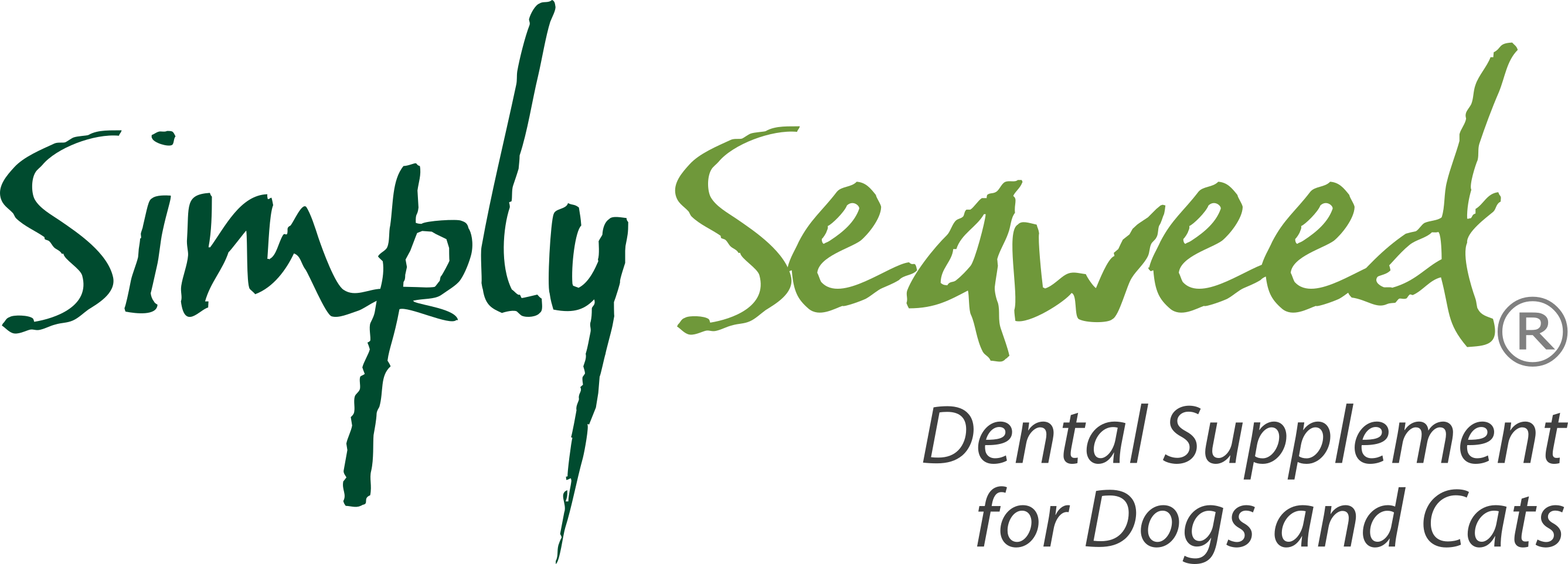Table of Contents
Signs
Stages
Consequences
Risk Factors
Bad Breath
Prevention & Treatment
Glossary
Dental disease is the most common ailment affecting our pets – 80% of dogs and 70% of cats have some degree of dental disease by the age of three years. Most dental disease occurs below the gum line where it is not visible.
Signs
- Pain and discomfort in and around the mouth area
- Halitosis (bad breath)
- Staining and build-up on teeth
- Red, swollen and/or bleeding gums
- Blood apparent on toys (excluding teething puppies)
- Mouth ulcers and/or lumps
- Missing, rotting and/or loose teeth
- Favouring one side of the mouth when eating
- Reluctance to play with toys or eat
- Facial swelling and/or swelling under the eye(s)
- Chattering teeth
- Pawing at mouth
- Dribbling
- Lethargy
Stages
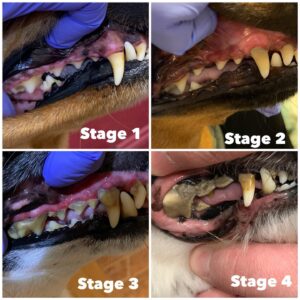
Dental Disease Stages, image from https://www.instagram.com/p/B8xgiKSpFsM/
- Grade 0 – Normal healthy teeth with no signs of dental disease
- Grade 1 – Gingivitis
- Grade 2 – Early periodontitis
- Grade 3 – Moderate periodontitis
- Grade 4 – Advanced periodontitis
Consequences
In addition to affecting the mouth, dental disease can contribute to a range of other health conditions including malnutrition, heart disease, liver disease and kidney disease, which can shorten the lifespan of your pet.
Risk Factors
Factors that can increase the likelihood of a dog or cat having dental disease are:
- Genetic Disposition
- Certain Breeds – such as Greyhounds, small & toy dog breeds and brachycephalic dog & cat breeds.
- Older Age – this is particularly relevant in small & toy breed dogs as they have longer lifespans.
- Being Overweight
- Allergies
- Soft Diet – pets that are fed soft food, such as tinned food, do not get the mechanical abrasion provided by bones and biscuits. Soft food is also more likely to get stuck in-between teeth.
- High Carbohydrate Diet – cheap kibble, biscuit bones and greyhound racing biscuits usually contain cereal, which is high in carbohydrates. Carbohydrates feed the oral bacteria that attack enamel.
- An Aversion to Chewing – some pets don’t like chewing bones or toys, or are very soft-mouthed when doing so. Some “inhale” their food instead of chewing it. Greyhounds are known for being lazy chewers.
- Chewing Patterns – some pets favour a particular side to chew with, resulting in reduced mechanical abrasion to the opposite side.
- Inadequate Prior Care – rescues (including ex-racing greyhounds) have often had their dental care neglected in their past life.
- Malocclusion (misalignment of teeth) – such as an overbite, underbite or crossbite. Overbites are common in Collies, Shetland Sheepdogs, Chihuahuas and Dachshunds. Underbites are common in brachycephalic breeds.
- Crowded Teeth – overlapping of teeth results in food getting trapped in hard-to-reach places. Crowded teeth are common in small & toy breed dogs, due to their mouths being so small.
- Persistent Deciduous Teeth (when baby teeth remain) – this is common in small & toy breed dogs.
- Narrow Muzzle – a narrow muzzle can lead to periodontal pockets that accumulate bacteria.
- Hairy Muzzle
- Cleft Palate
- Stomatitis (inflammation of the mouth) – CUPS (Chronic Ulcerative Paradental Stomatitis) is common in greyhounds. FCGS (Feline Chronic Gingivostomatitis) is also known as Feline Stomatitis.
- Certain Medical Conditions – such as skin disorders/diseases, FIV (Feline Immunodeficiency Virus), FCV (Feline Calicivirus), FHV (Feline Herpesvirus), FeLV (Feline Leukemia Virus) and bartonella.
- Certain Medications – some medications can cause gingival hyperplasia.
Bad Breath
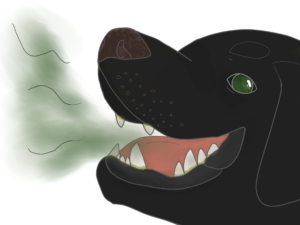
Artwork by Kate Clayton
The medical term for bad breath is Halitosis. It is unpleasant for us as well as our pets!
Causes include:
- Dental disease
- Certain medical conditions such as tonsillitis
- Coprophagia (eating faeces)
- Licking of anus – can be due to full/irritated/infected anal glands, worms, consuming spicy food, or sores due to passing sharp bone fragments or other objects
- Sticks, bone fragments or rotting food stuck in teeth or lodged in the back of the mouth/throat
Prevention & Treatment
Our teeth need to be regularly cleaned and maintained, and so do our pets’. Maintaining good dental hygiene is the best way to prevent dental disease and bad breath. Prevention is better than cure!
Pet dental care is not a one-size-fits-all approach, nor can any one thing get the job done. You may need to try some different approaches to find out what works best for both you and your pet.
Veterinary Checkups & Cleaning
Just like humans, dogs and cats also need to visit the dentist! All veterinarians are trained in basic pet dentistry, while complex issues are referred to a veterinary dental specialist.
A dental check-up should be performed once a year by your pet’s veterinarian. This generally consists of a simple examination of the mouth and does not require any sedation. This may also be required by some pet insurance companies.
A dental scale and polish (known as a “Dental”) may be recommended by your veterinarian – most dogs and cats require a few of these during their lifetime. During a Dental your pet will be put under a general anaesthetic. The procedure is routine, quick and safe. Dental Month in Australia is August so during this time many vet clinics have promotions on Dentals.
There are businesses offering anaesthesia-free teeth cleaning (also known as non-sedation teeth cleaning and Nonanesthetic dentistry (NAD)), however, this method is not recommended by the Australian Veterinary Association due to safety and efficacy concerns (see https://www.ava.com.au/policy-advocacy/policies/companion-animals-health/anaesthesia-free-dentistry-in-dogs-and-cats/).
Diet
Kibble
The majority of pet owner feed their cats and dogs kibble (also known as cat/dog biscuits or dry food). Whilst dogs and cats often prefer the texture of wet (canned) food, kibble is better for their teeth due to its texture. The dry rough surface of kibble provides good mechanical abrasion that helps to scrub away plaque and is also less likely than wet food to get stuck in gaps between teeth. If your pet scoffs their kibble they may not be getting the full benefit, so try a slow feeder bowl (also known as a gulper bowl).
There are a number of good quality kibble products available that have been specifically developed for dental care. These products usually have a large or specially shaped biscuit to encourage chewing and/or mechanical abrasion, as well as dental benefiting ingredients such as sodium tripolyphosphate (also known as pentasodium triphosphate, sodium triphosphate or just tripolyphosphate) and/or catechins. Such products are:
For Dogs
- Advance Triple Action Dental Care
- Delicate Care Dental Diet
- Hill’s Prescription Diet t/d
- Hill’s Science Diet Oral Care
- Royal Canin Dental Care
- Royal Canin Veterinary Dental
For Cats
- Advance Triple Action Dental Care
- Delicate Care Dental Diet
- Hill’s Prescription Diet t/d
- Hill’s Science Diet Oral Care
- Royal Canin Oral
- Royal Canin Veterinary Dental
Raw Feeding
Raw feeding (also known as a fresh food diet or BARF meaning Bones & Raw Food or Biologically Appropriate Raw Food) is becoming increasingly popular for both dogs and cats. Raw feeding helps maintain good dental hygiene as it is low in carbohydrates and incorporate bones.
Bones & Chews
Bones and chews both clean teeth and provide mental enrichment. Their hardness scrapes plaque from teeth, whilst the saliva generated from the prolonged chewing action helps to wash away food particles and neutralise acids.
Raw Bones
It’s not just dogs that eat bones, cats can have them too! Bones can either be given recreationally, or as part of your pet’s regular diet. Choose a bone that is suitable for the size of your pet. Supervise pets that are new to bones or that scoff their food. Never feed your pet cooked bones (as cooked bones may splinter into shards) and remember to practise good hygiene when handling raw meat. Pet nutritionists do not recommend feeding weight bearing bones from large animals (such as beef marrow bones) as their density can result in cracked teeth.
Natural Chews
- Beef hide rolls
- Bully sticks (also known as bull sticks, bull penis, beef pizzle, bladder sticks, doodle noodles or d**k sticks)
- Cow hooves
- Goat horns
- Shark fins and skin rolls
- A whole or half fresh coconut
- Carrots
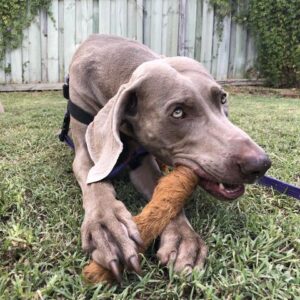
SkinnyDog Pet Treats Beef Hide Roll, image from https://skinnydogpettreats.com
Functional Treats for Dogs
Functional Treats for Cats
Tooth Brushing
While brushing a dog or cat’s teeth is often considered the best way of maintaining their dental hygiene, it is certainly not one of the easiest!
It is best to start training your pet to accept their teeth being brushed, and mouth examined, when they are a puppy/kitten. Start by getting them used to you pulling back their lips and opening their mouth – make it a positive experiencing by using reward based training.
Toothbrushes
There are two different types of toothbrushes available for pets – the finger brush and the “normal” style toothbrush. If you are worried about your pet accidentally (or purposely!) biting your fingers, then a normal style toothbrush is a better choice as it keeps your fingers at a greater distance from their teeth. Choosing a toothbrush with a multi-angled head will provide greater coverage across the surface areas of the teeth.
Effective alternatives to commercial finger brushes include a piece of pantyhose, gauze or flannel. You can also use your thumbnail to loosen plaque.
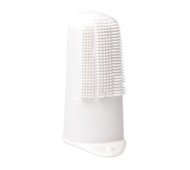
Dentipet Finger Brush, image from https://www.ceva.com.au
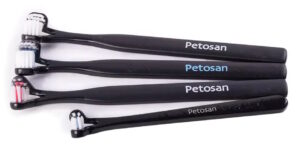
Petosan Double-Headed Toothbrush, image from https://petosan.com
Toothpaste
You don’t have to use toothpaste with a toothbrush, but it will increase the efficacy. Do not use toothpastes made for humans as they may contain ingredients (such as xylitol) that are toxic to pets. They may also contain too much fluoride which can be harmful to your pet as unlike us, our pets do not spit the toothpaste out. There are lots of recipes available on the internet if you are keen to make your own toothpaste.
Toys
Whilst dogs are usually the one to play with toys, there is no reason that cats can’t too! Any toy that encourages mouth-play will be beneficial to your pet’s dental health, due to the mechanical action applied to teeth and gums. This includes plushies (also known as soft toys), rope toys, chew toys and dental toys. Playing tug is a great way to clean your dog’s teeth whilst having fun. Animals will often have a bite grip that is different for playing, tugging and eating, so toys can help to clean different areas of the mouth.
There are several toys specifically designed for dental benefits. If your pet requires a bit of encouragement to chew on a dental toy, try smearing a little Vegemite or peanut butter on it.
For Dogs
- Dogit Design Gumi
- Hartz Chew ‘n Clean
- Kong dental range
- Nylabone chew toys
- PetSafe Busy Buddy Bristle Bone
- Sporn Marrow
- Tastybone
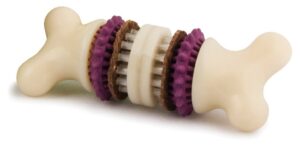
PetSafe Busy Buddy Bristle Bone, image from https://petsafe.com
For Cats
Dental Products
Food Additives
- Ascophyllum nodosum – a species of seaweed proven to have antibacterial, anti-inflammatory and anti-plaque properties. Our favourite brand is Simply Seaweed of course!
- Some pet owner’s find adding parsley, mint and/or charcoal to their pet’s food can help to combat bad breath.
Water Additives
- Oxyfresh Water Additive
- Prozym Solution
- Teef
- TropiClean Fresh Breath Water Additives & Drops
- Virbac Hexarinse & Aquadent Fr3sh
Sprays, Wipes & Gels
- Imperial Pet Co. Deer Velvet and Manuka Oral Spray
- Maxi/Guard Wipes, Drops, Gel & Spray
- TropiClean Fresh Breath Wipes, Gels & Sprays
Glossary
- Calculus – An off-white, yellow or brown hardened form of Plaque. More difficult to remove than Plaque. Leads to Halitosis, Tooth Decay and Periodontal Disease.
- Cavity – Another term for Tooth Decay.
- Dental Caries – Another term for Tooth Decay.
- Dental Disease – Usually another term for Periodontal Disease but may also refer to Tooth Decay.
- Feline Stomatitis – A painful inflammatory condition of the mouth in cats. Also known as Feline Chronic Gingivostomatitis (FCGS).
- Gingivitis – Inflammation of the gums, a mild form of Periodontal Disease.
- Gum Disease – Another term for Periodontal Disease.
- Halitosis – The medical term for bad breath.
- Oral Disease – A health condition affecting the mouth, such as Periodontal Disease, Tooth Decay, cancer etc.
- Periodontal Disease – Inflammation and infection of the gums.
- Periodontitis – Another term for Periodontal Disease.
- Plaque – A colourless or pale-yellow film of bacteria that sticks to the teeth. Leads to Calculus, Halitosis, Tooth Decay and Periodontal Disease.
- Tartar – Another term for Calculus.
- Tooth Decay – Breakdown of teeth. Permanent damage. Caused by Plaque.
Disclaimer: Information and products discussed on this page are of a general nature and does not account for your pets’ specific needs. If in doubt, consult your veterinarian. Simply Seaweed is not liable for any undesired outcomes arising from undertaking any of the suggestions. Products and brands mentioned are not affiliated with Simply Seaweed.
